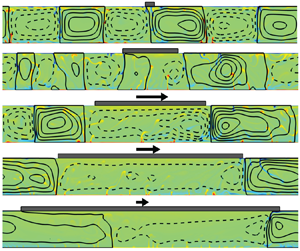Article contents
An insulating plate drifting over a thermally convecting fluid: the effect of plate size on plate motion, coupling modes and flow structure
Published online by Cambridge University Press: 06 April 2021
Abstract

As a simplified model to study continental drift over the convective mantle, a thermally insulating plate is introduced to float freely over a bottom-heated thermally convecting fluid. Results of numerical simulations reveal that plate size plays an essential role in plate motion and the flow--structure interaction. The insulating plate exerts a thermal blanket effect on the flow underneath by locally accumulating heat and modifying the flow structure. As the thermal blanket effect enhances with plate size, the plate becomes increasingly capable of overcoming the impeding flow and continue its movement. As plate size increases, plate motion transitions from long durations of stagnancy over cold downwelling, to short-term stagnancy over newly formed hot upwelling and eventually to a unidirectionally moving mode (UMM) with no stagnancy. For the UMM, a hot ‘propelling plume’ is always observed near the trailing edge of the plate, moving with the plate and generating a convection cell that propels the plate. However, it moves toward the plate centre as the plate extends to cover almost the entire flow domain. The average plate speed is revealed to be proportional to the multiplication of the average plume distance and the open surface area. The critical plate sizes for the UMM predicted by a simplified model agree well with results of the full numerical simulations. Moreover, spectra of the streamfunction field show that an increase in plate size induces longer-wavelength structure, and an increase in plate speed is accompanied by an enhanced dominance of longer-wavelength structure.
- Type
- JFM Papers
- Information
- Copyright
- © The Author(s), 2021. Published by Cambridge University Press
References
- 10
- Cited by



